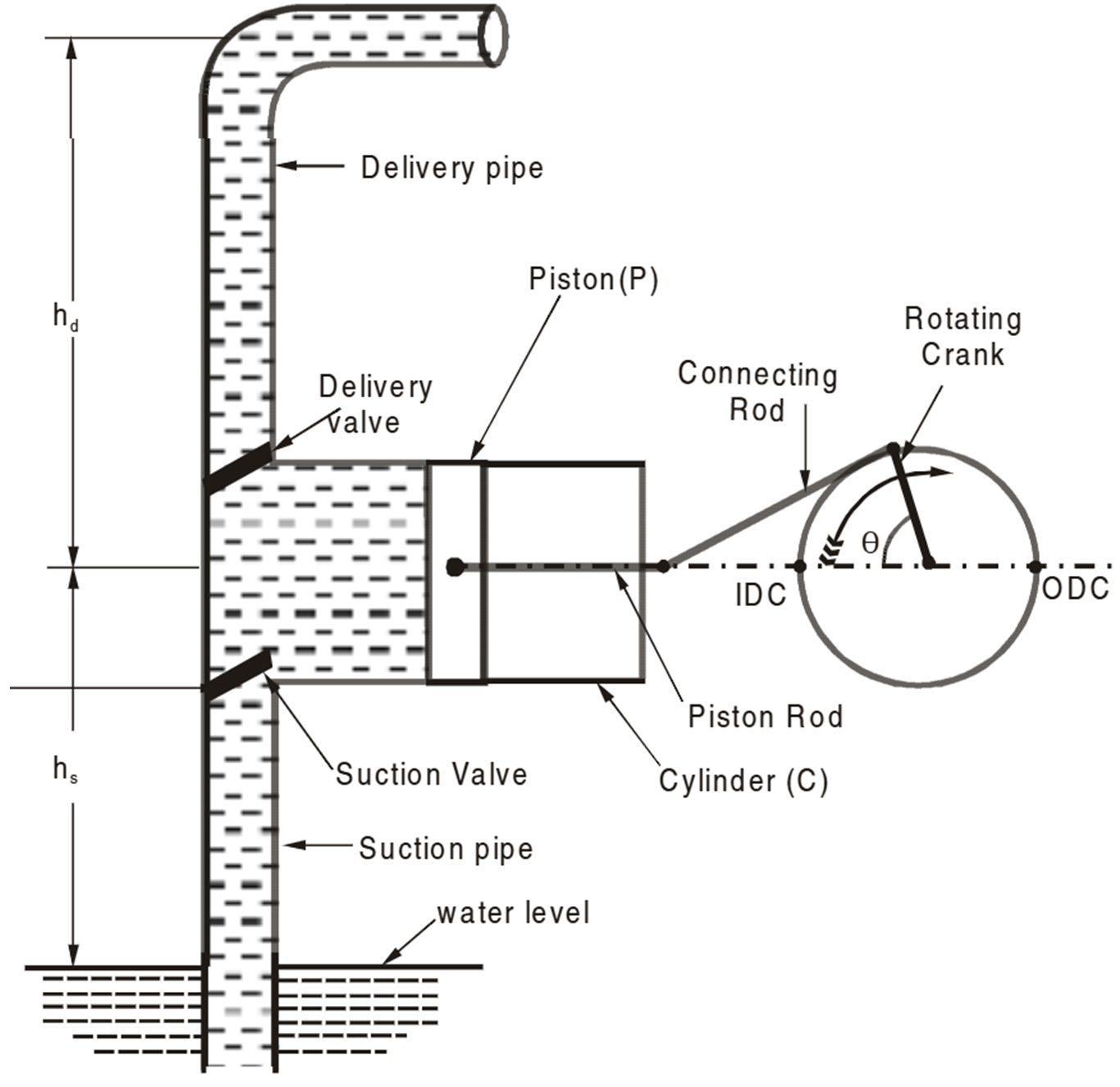A reciprocating pump is a type of positive displacement pump that utilizes a piston or plunger to move fluids by reciprocating motion. These pumps are used in applications requiring high-pressure fluid delivery, such as hydraulic systems, oil refineries, and chemical plants.
What is Reciprocating Pump?
A reciprocating pump is a mechanical device that moves a fluid by using a piston or plunger that oscillates back and forth within a cylinder. This motion creates pressure differences that draw fluid into the pump during suction and expel it during discharge.

Parts of a Reciprocating Pump
The essential parts of a reciprocating pump are:
1. Cylinder (C): Houses the piston and allows reciprocating movement.
2. Piston or Plunger (P): Moves back and forth within the cylinder to generate suction and discharge.
3. Suction Pipe: Carries fluid from the source to the pump.
4. Suction Valve: A one-way valve that allows fluid to enter the cylinder during suction but prevents backflow.
5. Delivery Pipe: Transports fluid from the pump to the desired location.
6. Delivery Valve: A one-way valve that allows fluid to exit the pump during discharge but prevents return flow.
7. Crank and Connecting Rod: Converts rotary motion into reciprocating motion.
8. Piston Rod: Connects the piston to the crank mechanism.
9. Drive Mechanism (Motor or Engine): Provides rotational energy to drive the crankshaft.
Working Principle of Reciprocating Pump
The reciprocating pump works on the principle of positive displacement, meaning it delivers a fixed amount of liquid per cycle.
Working Cycle
Suction Stroke:
- The piston moves backward (left in the diagram).
- This creates a vacuum inside the cylinder.
- The suction valve opens, allowing fluid to enter from the suction pipe.
Discharge Stroke:
- The piston moves forward (right in the diagram).
- This increases the pressure inside the cylinder.
- The suction valve closes, and the delivery valve opens, forcing fluid into the delivery pipe.
This cycle repeats continuously, creating a steady flow of liquid.
Types of Reciprocating Pumps
| Type | Description |
|---|---|
| Single-acting Reciprocating Pump | Pumps fluid in one direction with a single suction and discharge stroke. |
| Double-acting Reciprocating Pump | Pumps fluid in both directions, providing suction and discharge on both sides of the piston. |
| Single-cylinder Reciprocating Pump | Has a single cylinder for fluid movement. |
| Multi-cylinder Reciprocating Pump | Uses multiple cylinders to provide a smoother flow and reduce pulsation. |
| Plunger Pump | Uses a plunger instead of a piston, designed for high-pressure applications. |
| Diaphragm Pump | Utilizes a diaphragm for pumping, commonly used for corrosive and abrasive fluids. |
Advantages of Reciprocating Pumps
High Pressure Handling: Can generate very high pressures compared to centrifugal pumps.
Accuracy & Precision: Delivers a fixed volume per stroke, making it ideal for metering applications.
Self-Priming Capability: Can function even when the suction side is not fully filled with liquid.
Handling of Viscous Fluids: Suitable for pumping thick, sticky, and high-viscosity fluids.
Capability to Handle Slurries & Abrasive Fluids: Special versions like diaphragm pumps can handle abrasive materials.
Disadvantages of Reciprocating Pumps
Complex Design: More parts and moving components lead to higher maintenance requirements.
Pulsating Flow: Causes pressure fluctuations, requiring dampers to smooth out the flow.
Lower Efficiency at High Flow Rates: Not suitable for high-volume applications compared to centrifugal pumps.
High Maintenance Cost: Requires frequent lubrication and maintenance due to wear and tear.
Bulky & Noisy Operation: Larger size and mechanical parts result in increased noise and vibration.
Applications of Reciprocating Pumps
Oil & Gas Industry: Used for injecting chemicals and maintaining pipeline pressure.
Water Supply Systems: Used in municipal water distribution and high-pressure cleaning systems.
Chemical Processing Plants: Handles corrosive and viscous fluids in industries.
Hydraulic Systems: Used in pressurizing hydraulic fluids for industrial applications.
Food & Beverage Industry: Pumps viscous liquids like syrups, honey, and sauces.
Pharmaceutical Industry: Used for precision fluid transfer in drug manufacturing.
Mining Industry: De-watering mines by pumping out water.
Different between Centrifugal Pump and Reciprocating Pump
| Feature | Reciprocating Pump | Centrifugal Pump |
|---|---|---|
| Working Principle | Uses a piston or plunger for fluid displacement. | Uses a rotating impeller to create fluid flow. |
| Flow Type | Pulsating flow. | Continuous flow. |
| Pressure | Capable of handling high pressures. | Suitable for low to medium pressure applications. |
| Efficiency | High efficiency at low flow rates. | High efficiency at high flow rates. |
| Application | Used in industries requiring precise fluid handling, such as chemical and oil refineries. | Commonly used in water supply, HVAC, and irrigation systems. |
| Maintenance | Requires frequent maintenance due to many moving parts. | Lower maintenance due to fewer moving parts. |
| Priming | Self-priming. | Needs priming before operation. |
Conclusion
A reciprocating pump is a positive displacement pump that delivers precise fluid movement using a piston or plunger. It is widely used in high-pressure applications where accuracy, reliability, and efficiency are crucial. While it has some drawbacks like pulsating flow and maintenance requirements, its advantages outweigh them in many industries, making it an essential component in fluid handling systems.
